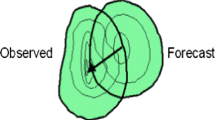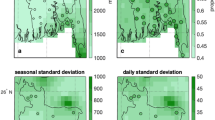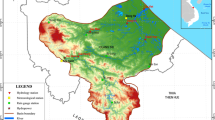Abstract
In the present study, a model output statistics (MOS) guidance model was developed by using the neural network technique for a bias-corrected rainfall forecast. The model was developed over the Indian window (0–\(40{^{\circ }}\hbox {N}\) and 60–\(100{^{\circ }}\hbox {E}\)) by using the observed and global forecast system (GFS) T-1534 model output (up to 5 days) at a \(0.125{^{\circ }} \times \,0.125{^{\circ }}\) regular grid during the summer monsoon (June–September) 2016. The skill of the developed MOS model forecast against the observed \(0.125{^{\circ }} \times 0.125{^{\circ }}\) grid rainfall data is obtained for the summer monsoon (June–September) 2017. The skill of the MOS model rainfall forecast is found to show good improvement over the T-1534 model’s direct forecast over the Indian window. In general, the T-1534 model’s direct forecast shows high skill but the forecast obtained by using the MOS model shows better skill than the direct model’s forecast, although a major improvement is seen for the Day 1 forecast at the national level. So the skill of the bias-corrected rainfall forecast by using the MOS guidance and the T-1534 model output is high and has the potential of being used as an operational forecast over the Indian region.












Similar content being viewed by others
References
Bhardwaj A, Kumar A and Maini P 2009 Statistical interpretation forecast and its skill during monsoon season in India; Int. J. Meteorol. 34(336) 39–47.
Durai V R and Roy Bhowmik S K 2013 Prediction of Indian summer monsoon in short to medium range time scale with high resolution global forecast system (GFS) T574 and T382; Clim. Dyn. 42(5–6) 1527–1551.
Durai V R, Roy Bhowmik S K and Mukhopadhaya B 2010 Performance evaluation of precipitation prediction skill of NCEP Global Forecasting System (GFS) over Indian region during Summer Monsoon 2008; Mausam 61(2) 139–154.
Glahn H R and Lowry D A 1972 The Use of Model Output Statistics (MOS) in objective weather forecasting; J. Appl. Meteorol. 11(8) 1972.
Jain P, Kumar A, Maini P and Singh S V 2002 Short range SW monsoon rainfall forecasting over India using neural networks; Mausam 53(2) 225–232.
Juang H M 2014 Regional spectral model workshop in memory of John Roads and Masao Kanamitsu; Bull. Am. Meteorol. Soc., ES61–ES65 5.
Kalnay E, Kanamitsu M and Baker W E 1990 Global numerical weather prediction at the National Meteorological Center; Bull. Am. Meteorol. Soc. 71 1410–1428.
Kanamitsu M 1989 Description of the NMC global data assimilation and forecast system; Wea. Forecast 4 335–342.
Kanamitsu M, Alpert J C, Campana K A, Caplan P M, Deaven D G, Iredell M, Katz B, Pan H L, Sela J and White G H 1991 Recent changes implemented into the global forecast system at NMC; Wea. Forecast 6 425–435.
Kumar A and Maini P 1996 Statistical interpretation of general circulation model: A prospect for automation of medium range local weather forecast in India; Mausam 47(3) 227–234.
Kumar A, Mitra A K, Bohra A K, Iyengar G R and Durai V R 2012a Multi-model ensemble (MME) prediction of rainfall using neural networks during monsoon season in India; Meteorol. Appl. 19 161–169.
Kumar A, Pai D S, Singh J V, Singh R and Sikka D R 2012b Statistical models for long-range forecasting of southwest monsoon rainfall over India using step wise regression and neural network; Atmos. Clim. Sci. 2 322–336.
Maini P, Kumar A, Singh S V and Rathore L S 2002 Statistical interpretation of NWP products in India; Meteorol. Appl. 9 21–31.
Murphy A H and Katz R W 1985 Probability, statistics, and decision making in the atmospheric sciences; Westview Press, Boulder Colorado, United States, 545p.
Pankaj J, Kumar A, Maini P and Singh S V 2002 Short range SW monsoon rainfall forecasting over India using neural networks; Mausam 53(2) 225–232.
Sela J 2009 The implementation of the sigma pressure hybrid coordinates into the GFS; NCEP Office Note #461, 25p.
Sela J 2010 The derivation of sigma pressure hybrid coordinates semi-Lagrangian model equations for the GFS; NCEP Office Note 462, 31p.
Yang F 2009 On the negative water vapor in the NCEP GFS: Sources and solution; In: 23rd conference on weather analysis and forecasting/19th conference on numerical weather prediction, 1–5 June 2009, Omaha, NE.
Acknowledgements
The authors gratefully acknowledge the valuable guidance given by Dr K J Ramesh, DGM, IMD, New Delhi, for carrying out the research work and writing and formatting this paper. Thanks are also due to IMD, Pune, for providing regular grid data for rainfall for the Indian window. Finally, the authors wish to thank the NWP division, IMD, New Delhi, for the assistance provided.
Author information
Authors and Affiliations
Corresponding author
Additional information
Corresponding Editor: A K Sahai
Rights and permissions
About this article
Cite this article
Kumar, A., Sridevi, C., Durai, V.R. et al. MOS guidance using a neural network for the rainfall forecast over India. J Earth Syst Sci 128, 130 (2019). https://doi.org/10.1007/s12040-019-1149-y
Received:
Revised:
Accepted:
Published:
DOI: https://doi.org/10.1007/s12040-019-1149-y




